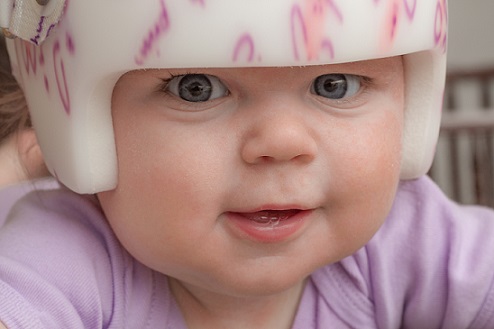If you notice that your newborn has a flat spot or abnormal head shape, the first thing you should do is consult with your pediatrician. Your child may have a condition known as plagiocephaly, which is an asymmetrical flattening of the skull. While this condition may reverse itself, your infant should be evaluated, especially if it continues for more than six weeks. A clinician can help you correct the problem or keep it from getting worse through repositioning and using “tummy time” to relieve pressure from flattened areas and build up neck and trunk muscles. When your baby is awake and supervised, having them lie on their stomach is also a good way to help them learn how to roll, sit, and crawl when the time comes.
If your baby winds up being diagnosed with plagiocephaly, brachycephaly or scaphocephaly and is between the ages of 3 and 18 months, a cranial specialist may recommend a STARband™ cranial remolding orthosis. STARband™ is a cranial helmet which is designed to correct your baby’s head shape, usually over a period of three to four months. Instead of squeezing your baby’s head into shape, cranial orthoses redirect growth and provide space into which the skull can grow.
A cranial specialist can use either of two scanning technologies, STARscanner® or SmartSoc®, to get the measurements needed to custom fit your child’s cranial helmet. Laser scanning is the twenty-first century replacement for the plaster casting process. Not only is it noninvasive, but it requires no eyewear or protection. And the scanned data is sent electronically and downloaded to create the orthosis to its precise specifications. STARscanner and SmartSoc technology also enable the orthotist to take measurements throughout treatment to identify any changes in your child’s head shape. For example, follow-up scans can be compared against the first scan to check for head symmetry.
STARband—the Gold Standard
More than 400,000 infants have been successfully treated with the STARband. The design is intended to allow for the successful completion of treatment for nearly all plagiocephaly and brachycephaly patients in a single orthosis. This presents a significant cost savings to the families and payers. Additionally, follow-up appointments are scheduled relative to the age of the infant and severity of the deformity, and this individualized schedule helps to decrease stress for the family.
STARband—One and Done!
Families must comply with the recommended 23-hour per day wearing schedule and participate in a structured follow-up program for ongoing adjustments and modifications to the STARband. If the clinical protocols are followed, there are rarely indications for a second headband.
Clinical Partners—STARband
Cranial Clinicians Partnering with an experienced cranial clinician is key to the success of the cranial care program. STARband cranial clinicians have extensive experience and expertise in the management of infants with skull deformities. Recommendations for STARbands are made only for infants with moderate to severe deformities, and orthotic treatment programs include ongoing adjustments to effectively direct cranial growth into the correct dimensions.
Advanced Pediatric Scanning Technologies
STARscanner and SmartSoc represent the leading scanning technology for infants with cranial deformities, as they were specifically developed to meet the needs of this patient population. Cranial scanners for infants must be safe, accurate and function quickly to capture the required head shape data from these active little patients. The STARscanner and SmartSoc systems are the most accurate laser and hand-held scanners available for cranial applications.
For more than two decades, the STARscanner has been used in doctors’ offices to capture head shape data from infants. More recently, the SmartSoc scanner was created for better portability and increased access to care for patients in more remote geographical areas. The advantage of SmartSoc is that it can go anywhere because it is an Android-based image capturing system that uses a smartphone to scan a baby’s head within two or three minutes. Moreover, its software is user-friendly and requires no special training. SmartSoc complements the STARscanner® technology by enabling nearly anyone to submit accurate data on their child’s progress and keep their orthotist abreast of any developments in your child’s head shape.
Clinical Documentation and Reports
Both the STARscanner and SmartSoc laser-scanning systems offer detailed anthropometric reports that establish baseline measurements during repositioning and therapeutic treatments. Additional scans are acquired as needed, and a comparative report shows both the qualitative and quantitative improvements obtained by the orthotic treatment program.
Commitment to Quality Cranial Care Programs
The STARband team involves a clinical network of exceptional clinicians dedicated to the care of infants with deformational plagiocephaly and post-operative craniosynostosis. Quality clinical outcomes depend upon the clinical skills of the STARband cranial clinician and use of the most effective orthotic designs.




